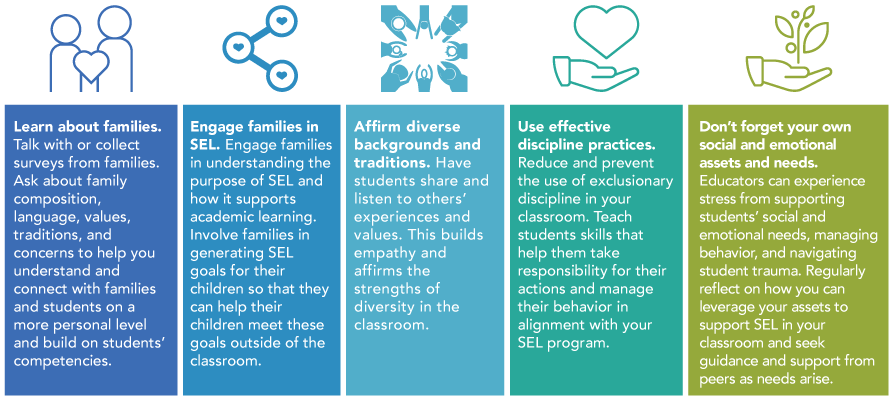We expect teachers to handle a lot: create engaging learning experiences, differentiate instruction based on student needs, manage behavior, motivate students to learn, and tackle persistent gaps and inequities. More and more, teachers are meeting this challenge by embracing social-emotional learning (SEL), which can support academic learning, teach and reinforce positive behavior, motivate students to be successful, and even support a more equitable classroom.
SEL programs are more likely to be successful with all students when they are grounded in strategies that promote equity. Equity means ‘leveling the playing field’ and creating a culture where all students feel fully included, respected, represented, and valued. In an equitable classroom, students have the tools and supports they need to be successful no matter where they start. SEL can support equity by making children feel safe, strengthening their relationships with peers and teachers, and helping children manage and express their emotions. SEL programs build upon individual student strengths to ensure that they can access and benefit from high quality educational opportunities.
Teachers need concrete, evidence-based strategies for bringing an equity lens to SEL.
How can teachers start to build equity into SEL efforts and use SEL to support equity? Here are a few strategies that start in the classroom.

- Learn about families. Talk with or collect surveys from families. Ask about family composition, language, values, traditions, and concerns to help you understand and connect with families and students on a more personal level and build on students’ competencies.
- Engage families in SEL. Engage families in understanding the purpose of SEL and how it supports academic learning. Involve families in generating SEL goals for their children so that they can help their children meet these goals outside of the classroom.
- Affirm diverse backgrounds and traditions. Have students share and listen to others’ experiences and values. This builds empathy and affirms the strengths of diversity in the classroom.
- Use effective discipline practices. Reduce and prevent the use of exclusionary discipline in your classroom. Teach students skills that help them take responsibility for their actions and manage their behavior in alignment with your SEL program.
- Don’t forget your own social and emotional assets and needs. Educators can experience stress from supporting students’ social and emotional needs, managing behavior, and navigating student trauma. Regularly reflect on how you can leverage your assets to support SEL in your classroom and seek guidance and support from peers as needs arise.
Additional resources on bringing equity into SEL
- 11 Ways Schools Can—and Should—Involve Families in SEL Programming. This article shares SEL practices that schools can use to engage families, and practices families can use to support SEL efforts at home.
- Pursuing Social and Emotional Development Through a Racial Equity Lens. This brief describes ways equity and social, emotional, and academic development can be mutually reinforcing. It also provides considerations for examining issues of race directly in SEL programs. The authors offer productive strategies such as:
- Building on student strengths, attending to root causes (such as discrimination, violence, homelessness, and hunger), addressing stereotype threat, respecting all cultures, providing needed resources, supporting adult social-emotional health, and engaging families and communities.
- School Guides for Incorporating Equity into SEL programs
- Applying an Equity Lens to Social, Emotional, and Academic Development. This issue brief describes some of the barriers that students face in developing social and emotional competencies and promising initiatives that apply an equity lens to SEL. Opportunities for eliminating barriers include:
- School racial and socioeconomic integration initiatives
- Restorative justice practices
- Trauma-informed system interventions
- Culturally competent and equity-literate educators
- SEL and mindfulness programming to support students and teachers
- Integrating a Focus on Equity into Social and Emotional Learning. This infographic summarizes some of the practices described in the issue brief above.
- Applying an Equity Lens to Social, Emotional, and Academic Development. This issue brief describes some of the barriers that students face in developing social and emotional competencies and promising initiatives that apply an equity lens to SEL. Opportunities for eliminating barriers include:
More on SEL
- Learn the basics of what SEL is, specific skills students develop when SEL is taught, and how a classroom can be impacted by SEL by reading Helping students help themselves.
- Get tips and resources on incorporating SEL into everyday academic instruction or selecting a standalone SEL program.
- Keep up with all of our posts on SEL by bookmarking our SEL Tag.
Topics: Classroom-based intervention Family engagement Social-emotional learning
